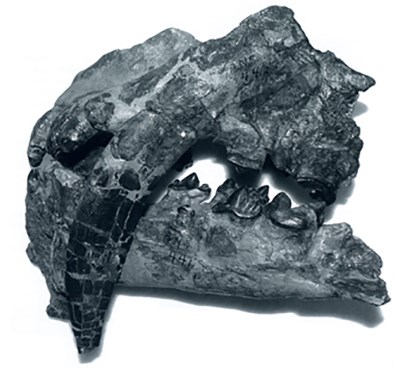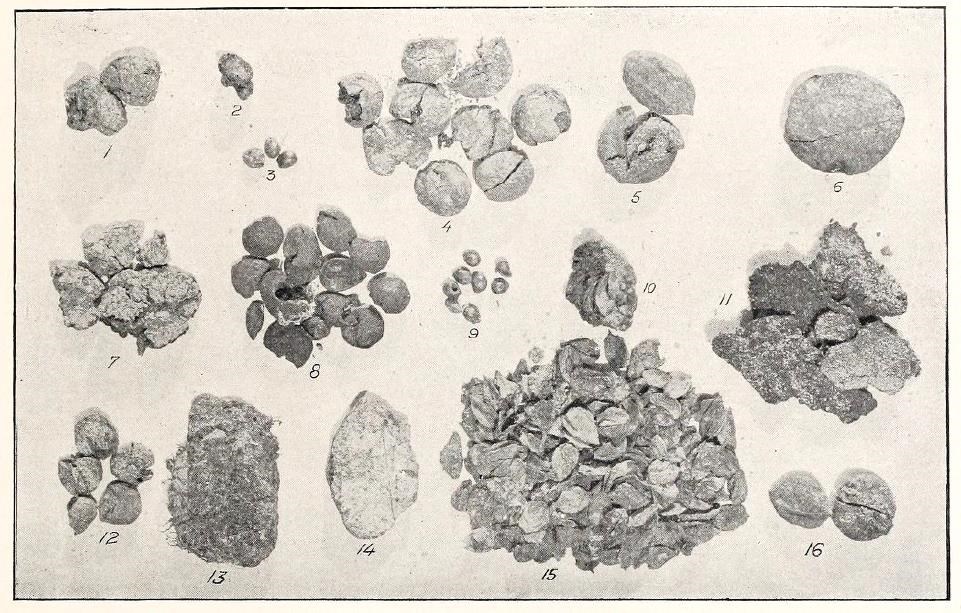Last updated: April 26, 2021
Article
Pleistocene Life and Landscapes—Valley Forge

Photo by Justin Tweet, used with permission of Ted Daeschler/Academy of Natural Sciences of Drexel University.
Port Kennedy Bone Cave
Article by Justin Tweet; Guest Scientist. National Park Service, Geologic Resources Division.
When the Continental Army spent the winter of 1777–1778 at Valley Forge in eastern Pennsylvania, they had no way of knowing they were practically on top of one of the richest fossil sites in eastern North America. Today, within the National Park Service's Valley Forge National Historical Park, there is buried an ancient fissure into which various mammals, birds, reptiles, insects, and plant fragments fell during the Middle Pleistocene. The site, known as Port Kennedy Bone Cave or just Port Kennedy Cave, was found in the 1870s and explored through the 1890s, but became inaccessible and then buried and forgotten until relocated in the 2000s. Its fossils belong to one of the most significant Middle Pleistocene faunas in the United States.

NPS photo from State of the Parks report.
Port Kennedy Bone Cave was discovered in 1870 during limestone quarrying in the Valley Forge area near the former town of Port Kennedy. The workers quarried into the cave from the side, revealing the fossil-bearing fill. Several scientists from the area visited the site to describe the fossils. Charles M. Wheatley was the first, followed by Edward Drinker Cope, both publishing preliminary findings in 1871. Today Cope is most famous for his part in the "Bone Wars," his competition with O.C. Marsh, but he published nearly 1,400 papers on many areas of the natural sciences, and he wrote about the Port Kennedy fossils at the beginning and the end of his career. The mammal fossils of the cave attracted the most attention, but other vertebrates, plant fossils, and insect fossils were also found. After the first excavation of the cave deposits, they were covered over. Later, in 1893, the cave was again exposed by quarrying activity, this time at a lower level. Additional fossil collections were made by Samuel G. Dixon and Henry C. Mercer from 1894 to 1896, when blasting accidentally allowed river water to flood the limestone quarry and fossil deposit, making further work impossible. The exact location of the site became forgotten over the years, and the quarry was used as a dump for industrial waste until it was filled. It was long rumored that a locomotive was crashed into the quarry for a now-lost 1915 silent film ("Valley of Lost Hope"), but a magnetic survey in 2004 did not find any evidence of a large metal object. Eventually, the area became covered with vegetation.



Port Kennedy Bone Cave is thought to have begun as an underground hole formed from the dissolution of the limestone, which became a sinkhole when the roof collapsed. Similar sinkholes appear today in certain parts of the country, such as Florida, where there is limestone bedrock saturated by groundwater. Over time, animals fell into the hole, died, and became buried by debris, which preserved their remains. Eventually the cave was filled with debris. These events took place several hundred thousand years ago, during the Middle Pleistocene. Although fossils from other places are often quite hard, the fossils from the cave deposits were very soft, due to the groundwater. Mercer described them as "wet and soft as over-ripe pears" when in the ground. Many were lost during excavation, and most of the specimens that survived were damaged, both from collection and from natural processes of crushing and water saturation. Complete skeletons were not found. Instead, the bones were scattered. The fossils that were recovered show that the area around the cave was forested and temperate to warm. Many but not all of the species found in the cave deposits are extinct today.

Seeds, leaves, twigs, and other plant fossils belong to about a dozen species. Most of the seeds represent hickory, beech, pine, and creeper. Most of the leaves belong to willow. Sphagnum moss was also found. Hickory also made up most of the identifiable wood, and oak was also present. A dozen species of beetles were found, but no other invertebrates were reported, or any fish. Amphibians and reptiles are represented by frogs, turtles, and snakes. The only bird appears to be a turkey. Many kinds of mammals were found, including: ground sloths, shrews, rodents, rabbits, pikas, bats, mustelids (including badgers, martens, otters, and wolverines), skunks, several varieties of felines (including bobcats, American cheetahs, and saber-toothed cats), dogs, foxes, short-faced bears, black bears, mastodons, horses, tapirs, deer, and peccaries. Common mammals of the late Pleistocene, like the giant beaver and mammoth, were not found, and there is only one doubtful possible bison bone. In approximate order, the most abundant mammals were sloths, rabbits, skunks, tapirs, short-faced bears, mastodons, and peccaries. To date, at least 49 species of fossil animals have been named from fossils found at the site. However, many of these species are now considered synonyms of other species, and only 15 or so of the reptile and mammal species are still in use. Among the most notable are the common Port Kennedy sloth Megalonyx wheatleyi; Smilodon gracilis, a saber-toothed cat; and an American cheetah, now known as Miracinonyx inexpectatus.
After the quarry filled with water, the site was forgotten and its exact location was lost until a series of technical surveys were made in 2004 and 2005. Several different ground-penetrating techniques were used to map the subsurface of the approximate area of the quarry and cave, based on differences between the cave fill (sand, mud, and clay) and the surrounding limestone. Slight differences in gravity and electrical conductivity were able to show the probable location of the cave. The cave deposits were not fully excavated in the 19th century, but it is unlikely that there will be any excavations anytime soon because of the hazardous waste and the water problems that interfered with the original excavations. Today, most of the fossils are in the collections of the Academy of Natural Sciences of Drexel University in Philadelphia and the American Museum of Natural History in New York. The Visitor Center of Valley Forge National Historical Park also occasionally displays some of the fossils. Scientists are still studying these fossils and revising their classifications.
Suggested Reading
- Cope, E. D. 1871. Preliminary report on the vertebrata discovered in the Port Kennedy Bone Cave. Proceedings of the American Philosophical Society 12:73–102.
- Cope, E. D. 1880. On the extinct cats of America. American Naturalist 14(12):833–858.
- Cope, E. D. 1895. The fossil Vertebrata from the fissure at Port Kennedy. Proceedings of the Academy of Natural Sciences of Philadelphia 47:446–450.
- Cope, E. D. 1896. New and little known Mammalia from the Port Kennedy bone deposit. Proceedings of the Academy of Natural Sciences of Philadelphia 48:378–394.
- Cope, E. D. 1899. Vertebrate remains from Port Kennedy bone deposit. Journal of the Academy of Natural Sciences of Philadelphia, 2nd series, 11(3):193–286.
- Daeschler, E. B., M. C. Lamanna, and M. Carfioli. 2005. On the trail of an important Ice Age fossil deposit. Park Science 23(2):31–34.
- Daeschler, E., E. E. Spamer, and D. C. Parris. 1993. Review and new data on the Port Kennedy local fauna and flora (Late Irvingtonian), Valley Forge National Historical Park, Montgomery County, Pennsylvania. The Mosasaur 5:23–41.
- Hay, O. P. 1923. The Pleistocene of North America and its vertebrated animals from the states east of the Mississippi River and from the Canadian provinces east of longitude 95°. Carnegie Institution of Washington Publication 322.
- Hojdila, J., T. DeMayo, S. Baughman, T. Bechtel, and M. Carfioli. 2005. The long-lost cave has been found! Park Science 23(2):35.
- Horn, G. H. 1876. Notes on some coleopterous remains from the bone cave at Port Kennedy, Penna. Transactions of the American Entomological Society 5:241–245.
- Mercer, H. C. 1899. The bone cave at Port Kennedy, Pennsylvania, and its partial excavation in 1894, 1895, and 1896. Journal of the Academy of Natural Sciences of Philadelphia 11:269–286.
- Scudder, S. H. 1890. The Tertiary insects of North America. Report of the United States Geological Survey of the Territories 13:1–734.
- Spamer, E. E., and E. Daeschler. 1995. Previously unfigured type specimens of fossil fish, reptiles, and mammals in the Academy of Natural Sciences of Philadelphia. Proceedings of the Academy of Natural Sciences of Philadelphia 146:429–458.
- Spamer, E. E., E. Daeschler, and L. G. Vostreys-Shapiro. 1995. A study of fossil vertebrate types in the Academy of Natural Sciences of Philadelphia: taxonomic, systematic, and historical perspectives. The Academy of Natural Sciences of Philadelphia Special Publication 16.
- Wheatley, C. M. 1871. Notice of the discovery of a cave in eastern Pennsylvania containing remains of post-Pliocene fossils, including those of Mastodon, Tapir, Megalonyx, Mylodon, etc. American Journal of Science and Arts, series 3, 1:235–237.
Related Links
- Grand Canyon National Park, Arizona—[Geodiversity Atlas] [Park Home]
- National Fossil Day
- NPS—Fossils and Paleontology
- Cave Paleontology
- Fossils through Geologic Time—Cenozoic Era
- NPS—Caves and Karst
